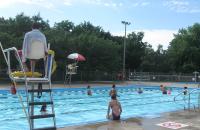Efficiently organizing supervision
Lifeguards need to be ready to intervene at any time when supervising an aquatic facility. Being in the right position, systematically scanning the area and planning lifeguard supervision at your pool or at your beach will help you detect and assist a distressed victim.
- Display your supervision plan. The whole pool needs to be supervised; create a plan that identifies each supervision position (patrols and chairs), the positioning according to the number of lifeguards, their zone coverage, rotations, etc..
- Use the lifeguard towers. Lifeguard towers allow lifeguards to have a better view of the bottom of the pool, since they counter the effects of reflects as well as refraction. Using lawn chairs for lifeguards must be forbidden.
- Apply the 10-30 rule when scanning the area. Scanning the area must be done in at least 10 seconds and under 30 seconds.
- Make rotations every 15 to 20 minutes. Make quick rotations between each tower to reduce boredom and ensure optimal vigilance.
- Take a break every 2 hours. Take a 15 minute break every 2 hours (at least) when supervising an aquatic facility.
- Stay hydrated to stay alert. You should drink to compensate for water loss. Consult the graphic (in French only) to know how much water you should drink depending on the temperature (taking sun and humidity into account). Loss of water equivalent to 1% of your body weight will have an impact on your ability to stay alert.
- Wear polarized sunglasses. They are designed to block the sunrays that reflect on water.
- Open your umbrella. Being under the shade of an umbrella when sitting in the lifeguard tower reduces the effects of the sun's heat and maximizes efficiency and vigilance.
- Lifeguards on walking patrol: move! Always keep moving when scanning your supervision zone. Make sure you also scan blind spots, and avoid staying in a stationary position at the same place.
- Cut out distractions. Only a few seconds are enough to distract you, thus reducing how much time you have to rescue a drowning victim; for example, having lifeguards side by side or on the same side of the pool must be forbidden.
- Know how to recognize distressed victims. Always keep looking for an inert body at the bottom of the pool, and when in doubt, react immediately.






